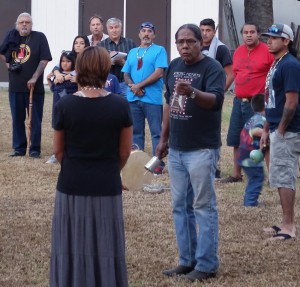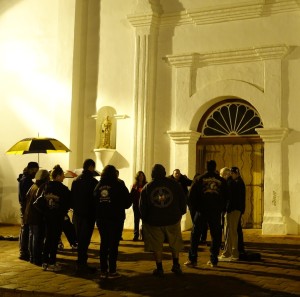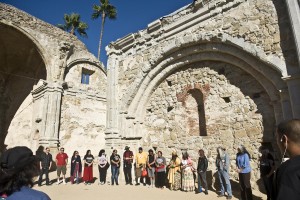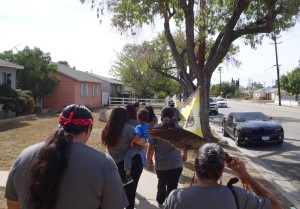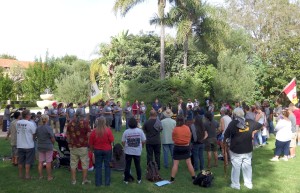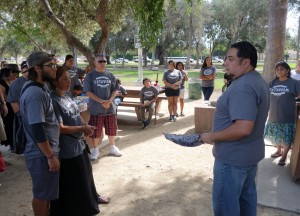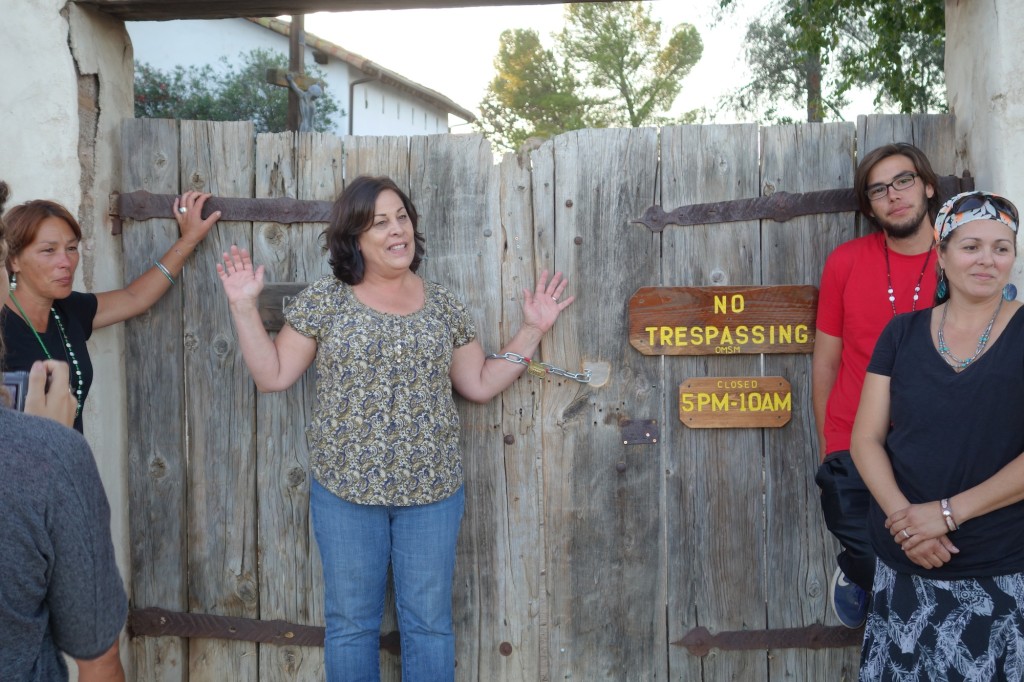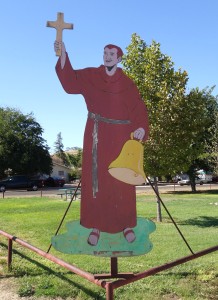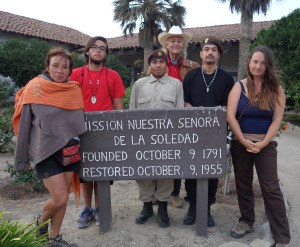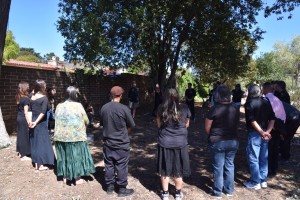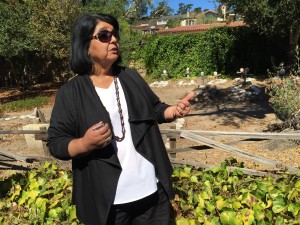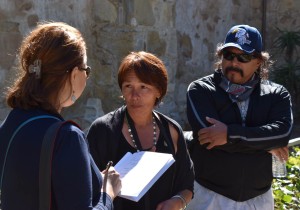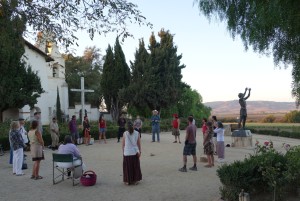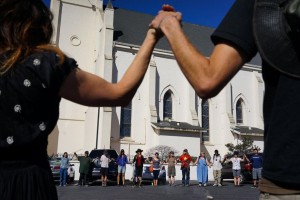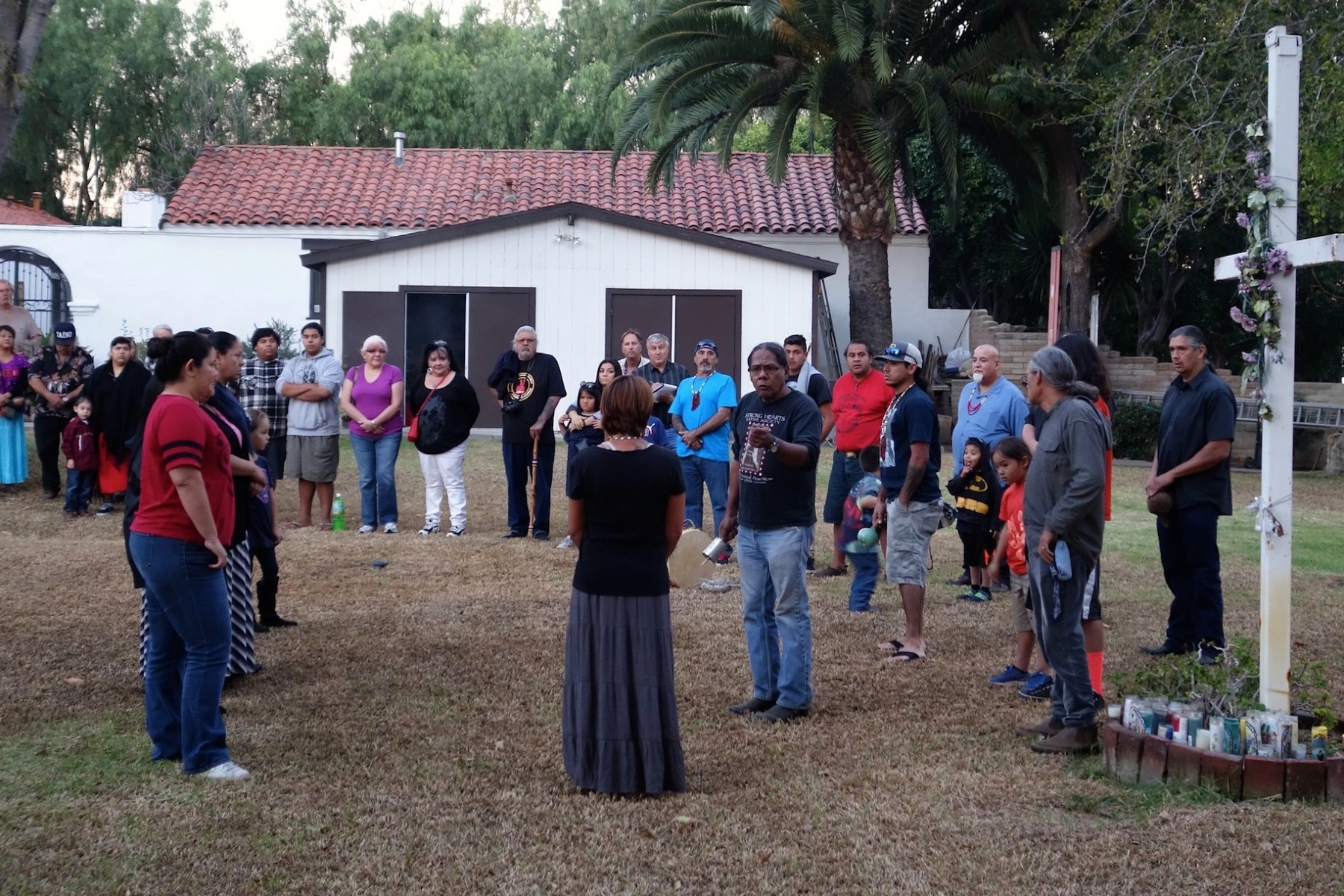
Posted on January 7, 2016
“This mission that our people burnt down”—Closing Ceremony in San Diego
On November 7th 2015, the Walk for the Ancestors reached its final destination at Mission San Diego after two months and what turned out to be over 780 miles of walking. 130 people joined together at dusk for the final ceremonies, including representatives from numerous Kumeyaay communities and reservations. Stanley Rodriguez from the Santa Ysabel reservation opened the gathering with a booming voice, speaking first in the Kumeyaay language, then translating to English.
“In front of me, here, are Ipai-Kumeyaay dancers from both sides of the border,” Rodriguez said. “We have come here today, to this mission that our people burnt down. Our people went to war with these people. And we still have our language, we still have our songs. We never let go. We are still native people, we are still part of this earth.”
“We’ve come here because this lady here, Caroline, has come from very far away, to bring attention to the plight of our people,” he continued. “To show that our spirit is strong. That we never forgot, we’ve never let go of who we are.” Read More
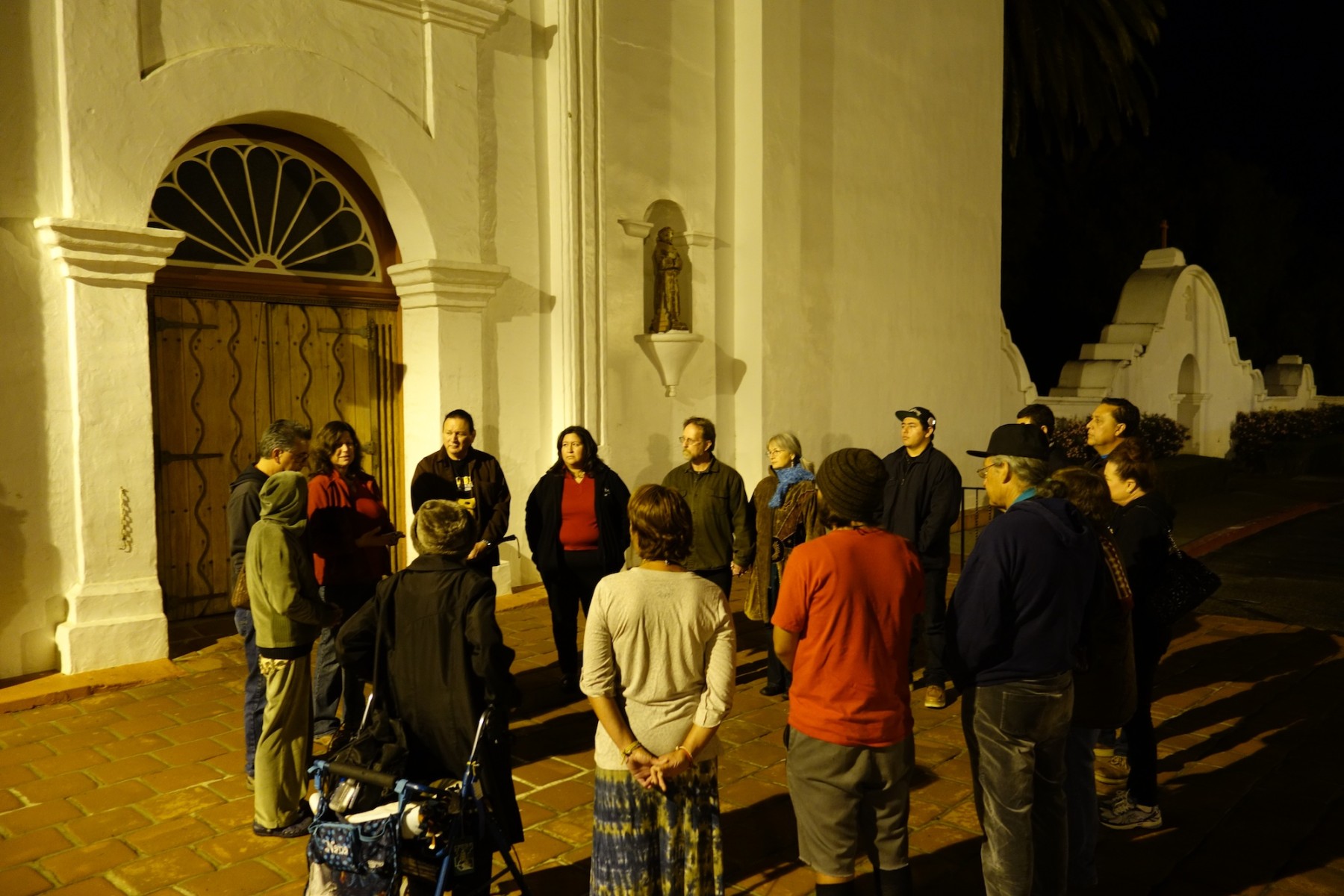
Posted on November 7, 2015
Together in the rain San Luis Rey » “El Camino Real was our Trail of Tears”
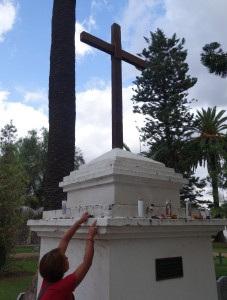
Caroline Ward Holland lighting candles and sage at the only burial marker on the SLR mission grounds for the 4,000+ Indians buried there.
On Tuesday at 5:30pm in from of Mission San Luis Rey, we stood on the steps of the chapel in pouring rain. It was dark out, except for the occasional flash of distant lightning. Nevertheless, we soon found ourselves surrounded by a circle of 20 people, standing with us in the cold. Most were tribal members of the San Luis Rey band of Luiseño Indians, though others hailed from the Pechanga band of Luiseño, the San Pasqual band of Kumeyaay, and nearby towns.
Mel Vernon, chairman of the San Luis Rey band, led an opening prayer and welcomed the walkers to Luiseño (Payómkawichum) territory. Tribal member Diana Caudell echoed his greeting. “I want to welcome people here, to our ancestral village, which is right down over there, and where the mission is now standing.”
“My great, great grandparents were slaves here at Mission San Luis Rey,” tribal member Max Moran said, with a booming voice. “We have a lot of stories about how badly they used to treat the Indians here. It’s just unbelievable, how bad. It breaks my heart in different ways. And seeing how all that is hidden, in the story they tell— everybody thinks that the missions did so much, but to us, it was just destruction. I could really go on about this— it makes me so angry.”
Read More

Posted on November 5, 2015
Mission San Juan Capistrano and the messages in the walls
On Sunday, November 1st, we reached San Juan Capistrano, navigating past a dizzying array of mission-themed tourist shops. “First there was Mission San Juan Capistrano,” an Acjachemen friend wryly remarked to us. “Then, there was Disneyland.”
In front of the mission, we were embraced by a warm welcome from Acjachemen women leaders, and many others who had come to join with us for a time of truth telling and healing. Although the circumstances of our coming together were not happy ones, by the time we left the mission, we felt truly uplifted and inspired.
With Acjachemen spiritual leader Adelia Sandoval and storyteller Jacque Tahuka-Nuñez in the lead, 50 people walked onto the mission grounds, forming a large circle amidst the ruins of the old stone cruciform church. Adelia blessed everyone in the circle with purifying sage, and opened the circle with a prayer to the ancestors, asking for them to be with us. She turned and gestured to the stone wall behind her. Read More
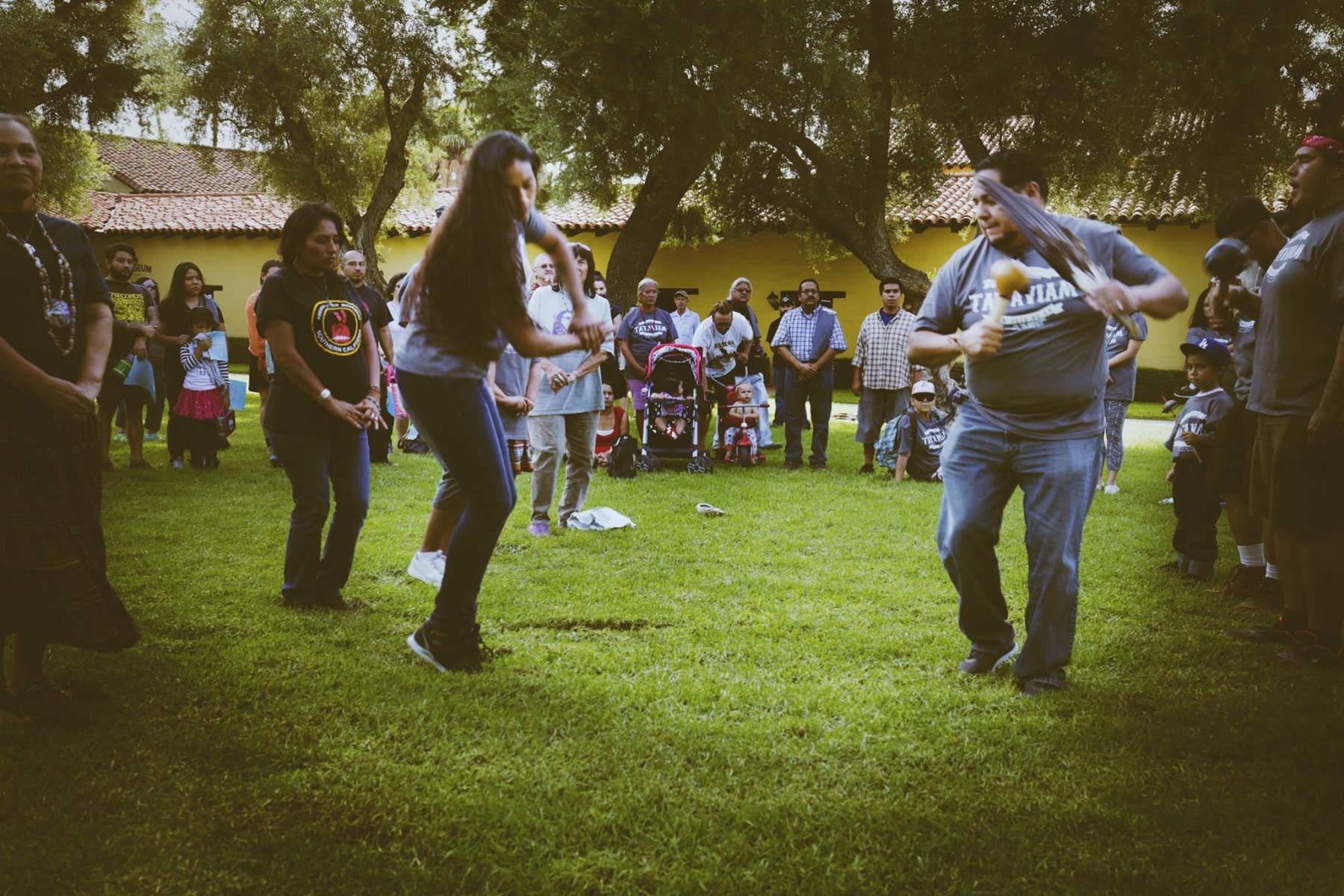
Posted on October 27, 2015
“This place is ours”—Tataviam families return to Mission San Fernando
Saturday, October 24th was an unforgettable day. Tataviam families gathered to receive the Walk for the Ancestors, taking over the plaza of Mission San Fernando for three hours with storytelling, traditional songs, and dance. It was the first time in memorable history that the Tataviam community has gathered at the mission grounds for purposes other than a funeral. Joined by other indigenous people and non-native supporters, over 100 of us stood together.
“Father Serra being a saint is not correct. It’s a slap in our faces, it’s disrespect to our cultures, and it’s still saying, from the Pope down, that we’re less than them,” stated Rudy Ortega, Jr, chairman of the Fernandeño Tataviam Band of Mission Indians.
“But today is not a day to look at what the Pope did,” Ortega continued. “Today is a celebration that our people are still here. And one of the things I said to the Pope, in a message to him: I said he made a mistake. Because what he did is he woke us up.”
“We ask the Creator to bless the people who came before us, the people who maintained our villages, and the people who struggled so that we, myself, and my children, and all of you, can stand here together. And I thank Caroline and her family for walking. Because Father Serra walked up, north, and now, she’s reversing that walk.” Read More

Posted on October 19, 2015
San Luis Obsipo: Grizzly Bears and Flaming Arrows
At San Luis Obispo, we were received by a strong circle of Northern Chumash families and other local native and non-native people, some from as far away as the Kern Valley Indian Community in Bakersfield. Chairwoman Mona Olivas Tucker of the Yak Tityu Tityu Northern Chumash tribe opened the circle with a prayer in the Chumash language.
“We’re here to greet you, to welcome you, and to show our support,” Mona said. “We’re from this area, this is where we were born, and our families have been here for at least 10,000 years. And I’m glad that we’re still here. We’re here always. And today, we’re thrilled to be a small part of your journey.”
“Now that the canonization is done, it doesn’t change anything,” Mona explained. “It doesn’t undo what was done in the past. And it doesn’t change our purpose, it doesn’t change our focus, it doesn’t change our goals and our aspirations: none of that’s changed.” Read More
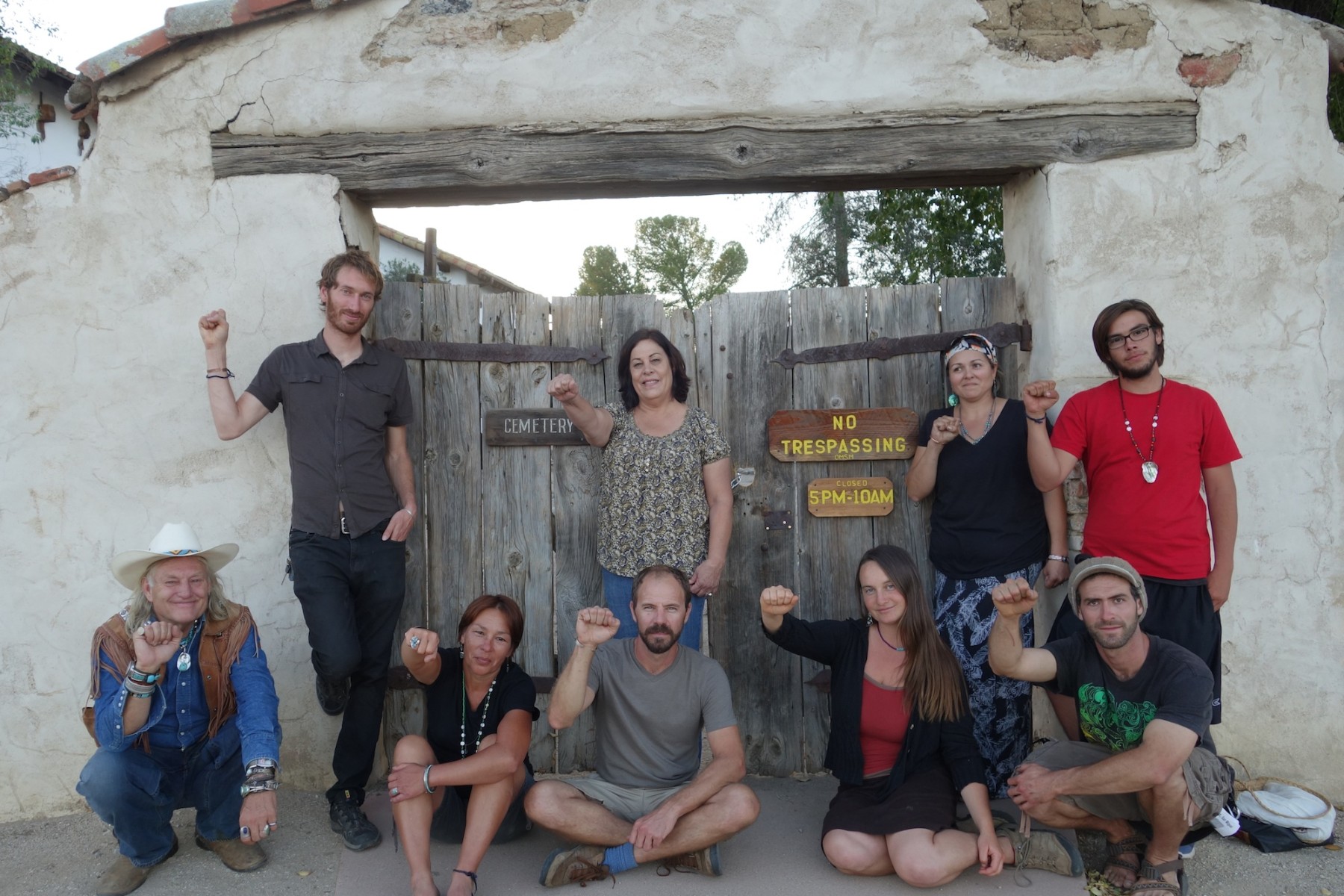
Posted on October 15, 2015
They tell on themselves: Stories of runaways and soldiers at Mission San Miguel
Just before sunset, we gathered outside the San Miguel mission cemetery, holding hands as Patti Dunton of the Salinan Tribe led a prayer and walked around us, singing a Salinan blessing song with a bull kelp rattle. She welcomed us and shared kind words of support and gratitude.
“We’re here today to honor our ancestors and those who came before us,” Patti Dunton said. “Thank you for getting the message out, thank you for getting the truth out. May you have strength to finish your journey. May you touch people’s hearts, so that they can understand the hurt from the past, that they might open their hearts up so we can heal the future, for all.”
While we were holding our circle outside the cemetery, the mission grounds were bustling with activity, as a Catholic wedding was underway. The gate to the cemetery was chained shut, so we asked the staff at the visitor center if they could let us in. They declined to grant us entry, stating that it was closed for repairs. We carried on with our circle, taking turns sharing reflections and stories pertaining to the mission. Read More
Posted on October 6, 2015
The missing burial ground: What’s not happening…in Soledad
We reached Mission Soledad in the afternoon of September 27th after traversing the bone-dry Salinas River and the vast maze of agribusiness operations that spans the Salinas Valley. Of all the 21 Missions, this is the one we knew the least about: information about its true history has been scarce and elusive.
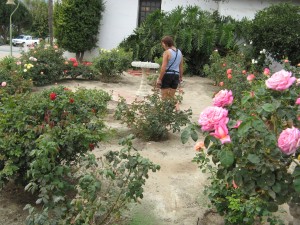
“These are peoples ancestors, their family relatives, do you understand that?” Caroline told the docent.
What we found upon reaching the mission proved disturbing beyond what we had imagined. “When we came in, I could feel the ancestors,” Walk leader Caroline Holland said. “I got here and started looking around and it just hit me. Like no, something’s wrong. There’s something big here, something terrible has happened here.” Gradually, the story began unraveling. Read More
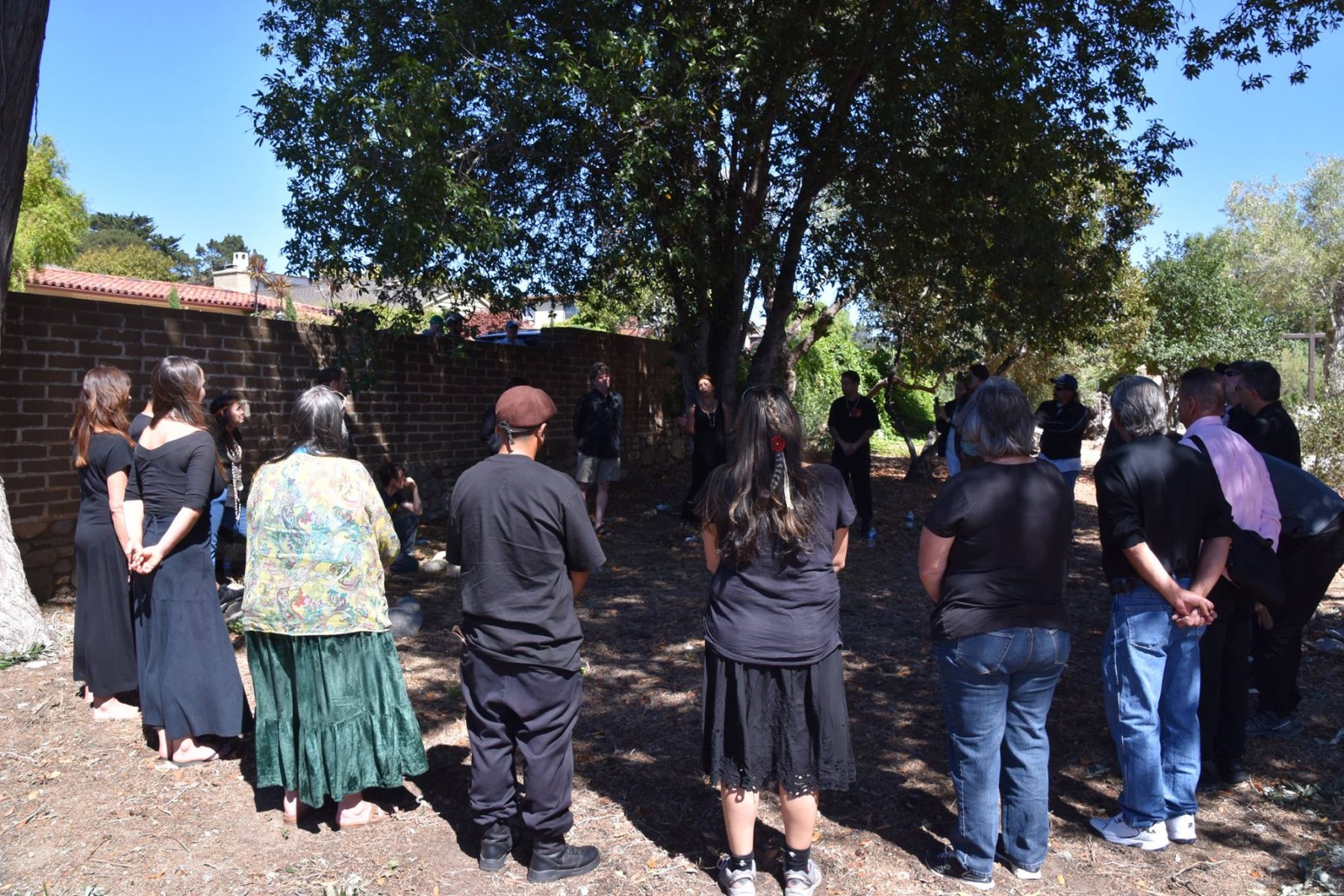
Posted on October 3, 2015
Reportback from Carmel: “It’s not over. This just makes us stronger.”
On the morning of September 23rd, we arrived to Mission Carmel, bracing ourselves for a day we had not been looking forward to. In the Mission courtyard, about 75 people sat in plastic chairs, enthusiastically preparing to watch a live feed of the Canonization Mass for Junipero Serra on a giant TV screen. Meanwhile, in the old cemetery where over 3,100 indigenous ancestors lie buried in unmarked graves, we gathered together with Esselen descendants and other native and non-native people, standing in mourning, prayer, and solemn opposition.
Louise Miranda Ramirez led a prayer in the Esselen language, acknowledging the land and her ancestors, and invited each person in the circle to introduce themselves. “I am glad that you have come, and shown this respect to our ancestors: So that they know we have not quit, and that we won’t quit. So that they know we will not forget them. That’s what important, that we never forget what they went through. And that we keep on fighting.”
Caroline Ward Holland, Tataviam descendant and leader of the 650-mile Walk for the Ancestors, also thanked everyone who came out to stand against the canonization. “They keep saying Serra was a man of his time. But there is no time, anywhere, anyplace, when it’s OK to be treated the way that our people were treated, by this horrible person who is being celebrated today.”
“They considered us subhuman,” Caroline continued. “By making Serra a saint, the Pope is basically putting a stamp of approval on everything they did. He’s saying that it’s OK to commit crimes against humanity, and whip people, and have slaves, and rape them, and take their children from them, and take them away from everything they know, and that’s OK.”
“Now that the Pope has given this person sainthood, he’s just made himself accountable for all the atrocities that happened at every Mission, and to every native person in the state of California,” Caroline said. “Because no one’s ever taken responsibility before. It’s time for the Church to take responsibility for all of the horrible things that they’ve done. It’s on them now.” Read More
Posted on September 21, 2015
Standing Vigil at Sunset in San Juan Bautista
After a long Sunday’s journey in the sweltering heat, we arrived at San Juan Bautista as the sun was preparing to set on the golden hills surrounding the valley. An eerie billboard on the edge of town reads, “Welcome to History,” depicting a pastoral scene of the Mission and a horse drawn-plough.
We were honored to be joined at the Mission by Mutsun Ohlone elder Ann Marie Sayers and a circle of community members including three young men from the Watsonville Brown Berets and three runners from Peace and Dignity Journeys. Ann Marie Sayers led a blessing and welcomed the walkers to Mutsun territory, informing us that the Mission was built upon the site of the village named Popeloutchom. She addressed the group with sharp clarity:
“When you walk in to this Mission, you do not see the name of the peoples that were here. You do not see any kind of representation of the Native peoples on whose land we are on right now. And by God, we’re still here. Thats who it is I want to respect and honor.” Read More
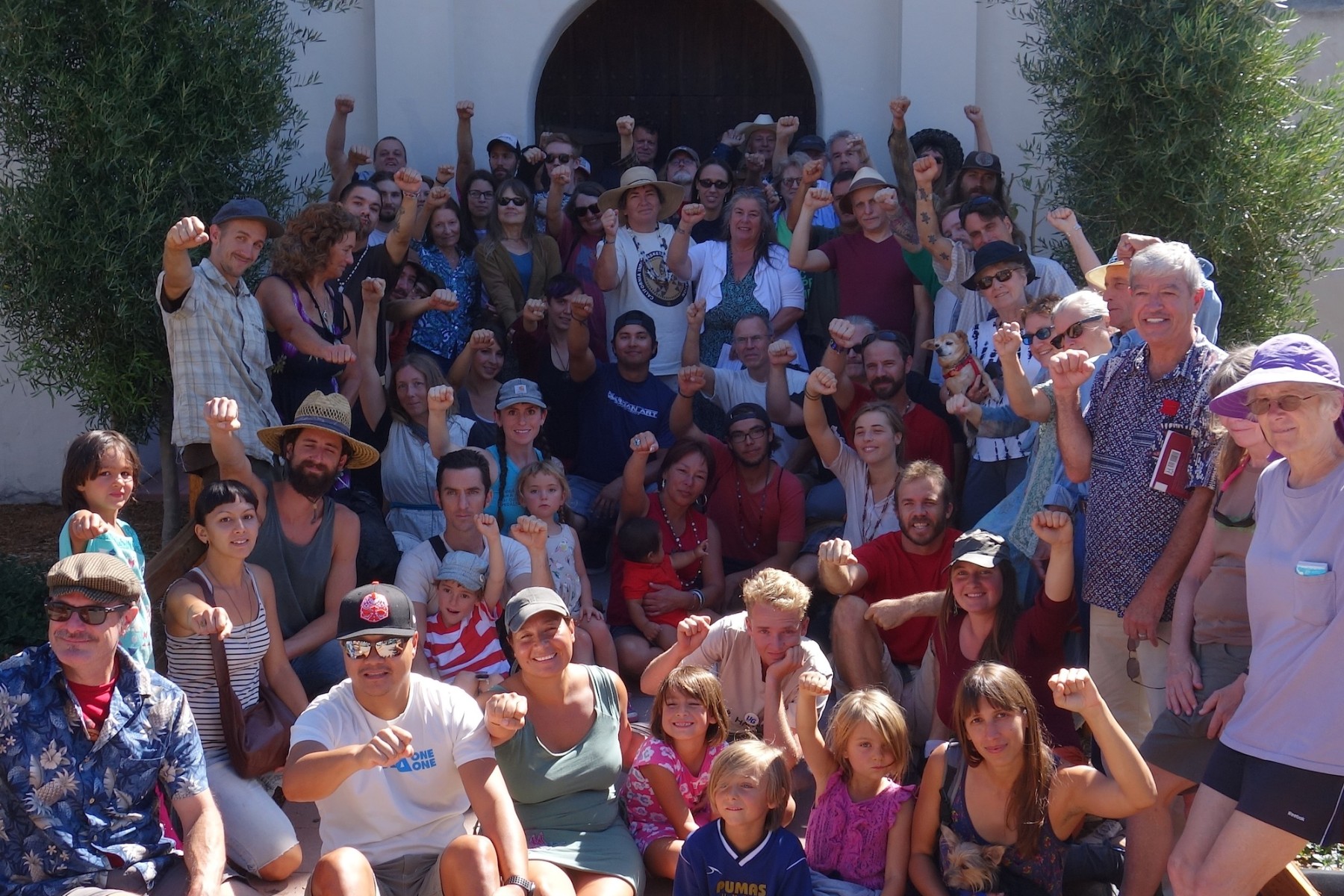
Posted on September 20, 2015
Standing for the Ancestors in Santa Cruz, 80 strong
Saturday morning, we stood together with over 80 people of all ages, forming a giant circle at the very place where Mission Santa Cruz once towered over this land. All spoke aloud in turn their reasons for being there. “To offer my deepest respects and my blessings to the walkers who have undertaken this courageous journey,” one woman said. “To acknowledge and grieve the suffering of the indigenous ancestors of this land, and learn the true stories of what happened here,” said another.
“In honor of my Cahuilla ancestors, who worked at Mission San Gabriel during the dark period of genocide.” said Valerie Jean Chase. “On behalf of my father, whose life was also so impacted by the Church,” voiced Theo Wilson, a Pit River Tribe descendant. “In support of my children, the next generation learning the truth. In teaching my children to care for the land, I want them to learn about the people who really cared for the land, and what happened to them,” said wilderness skills instructor Naali Aelfgifu. Read More

